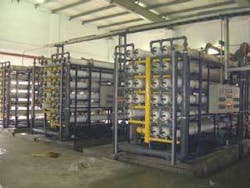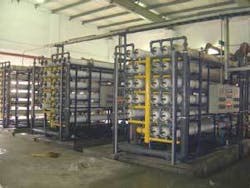Recycling mine wastewater solves water shortage problem at Tangshan steel
The Tangshan steel works in northeastern China overcomes water shortages by recycling mine wastewater using a membrane-based water treatment technology.
by John McArdle, Ruming Pang
The Tangshan Iron & Steel Group Co., Ltd. (TISCO) in the Hebei province of northeastern China met the challenge of creating a clean, reliable source of water for boiler makeup and steel plat cooling by installing a membrane-based water treatment plant to recycle mine wastewater.
TISCO is the sixth largest metallurgical enterprise in China, producing seven million tons of iron, steel and steel products in 2004. The supply of water for industrial use is limited due to the national shortage of freshwater. The situation is particularly serious in the north, home to 50 percent of the population and 65 percent of the farmland, but only 20 percent of the country’s water resources. The residents of Hebei have historically relied on the overflowing waters of the Yellow River and its tributaries, but the region has been plagued by long periods of drought in the past decade, making it even more challenging to obtain fresh water.
Water conservation and sustainable development was a central focus of the tenth Five-Year Plan of the People’s Republic of China. For example, Chapter 5 of the 2002 Water Law required all industries to extensively reuse water and increase water recovery, especially during new construction or plant upgrades. For the iron and steel industry, regulations specify water intake lower than 16 cubic meters per ton of product and water reuse ratio higher than 90 percent.
The Chinese government imposed a new water consumption ratio on seven industries in January 2005. Steel, power, petroleum and chemical, textile, papermaking, brewing and alcohol companies could now be charged a fee for any consumption of water over the allocated amount. If the situation is not rectified within a specified timeframe, the offending enterprises will lose access to water supplies.
TISCO needed a plan that minimized its usage of scarce municipal water supplies in order to gain approval for its expansion plans. The solution was to once again take advantage of the locally available resources and exploit an alternative water source - the wastewater in an abandoned coal mine fewer than five kilometers from the plant. The plentiful supply is a mixture of rainwater, groundwater and leached chemicals.
This mine contained a plentiful and reliable supply of water, but unfortunately, the water was difficult to treat because of its high quantity of suspended particles and dissolved solids, which were made up primarily of coal powder.
TISCO looked to a bordering province that had recently dealt with the same problem. “We found a water treatment solution that had been successful on similar water in another abandoned mine,” said Wanlin Tian, manager of the new water treatment plant at TISCO. “At the Datong Mine, in the bordering province of Shanxi, they have been converting mine water into high quality drinking water for the people of the region since June 2003. We used the Datong system as a model for the new Tangshan Steel Works water treatment plant,” he explained.
The core of the treatment plants, at both the Datong Mine and the new TISCO plant, is reverse osmosis (RO) membranes from Koch Membrane Systems, Inc., (KMS) based in Wilmington, Massachusetts, USA. The two plants also use KMS ultrafiltration (UF) membranes to pretreat the water prior to RO. The Huadian Water Treatment Technology and Engineering Co. Ltd. supplied the new TISCO plant, which was commissioned in July 2004.
Treatment process
The first stage of treatment at TISCO is conventional pretreatment involving coagulation, flocculation and sedimentation. After the pretreatment, the total suspended solids are about 20-100 mg/l and the turbidity is approximately 5 NTU. The total dissolved solids are in the range of 5-600 mg/l.
The second stage of treatment is ultrafiltration, which is performed by 46 KMS 8-inch (213mm) diameter TARGA® UF cartridges in three parallel trains with a total capacity of 680 m3/hr. These hollow fiber cartridges have proprietary polysulfone membrane chemistry with a nominal molecular weight cut-off of 100,000 daltons. The high chlorine resistance (up to 200 parts per million at 10.5 pH) and pH tolerance (from 1.5 to 13) make these hollow fiber cartridges relatively easy to clean. The UF system removes suspended solids and turbidity to ensure excellent water quality for the RO feed.
The third stage is the reverse osmosis system. Three trains have a total capacity of 500 m3/hr. Each train has 108 Fluid Systems® TFC®-HR Magnum® spiral wound RO elements manufactured by KMS. The thin film composite membrane is made of a proprietary polyamide that provides high rejection at a relatively low RO operating pressure. The 60-inch- (1,524 mm) long Magnum elements were selected over 40-inch- (1,016 mm) long elements to minimize the number of components in the system. An additional stage of treatment using ion exchange is employed for polishing of water destined for use as boiler make-up water.
The Tangshan Steel Works serves as a model of sustainable economic development. RO systems with ultrafiltration pretreatment can take polluted and formerly unusable water sources, such as the water in abandoned mines like Datong and Tangshan, and turn it into high quality water that can fuel industrial growth and help quench the drinking water needs of an entire population.
Authors’ Note
John McArdle and Ruming Pang work for Koch Membrane Systems, Inc., located in Wilmington, Massachusetts, USA.

